




















An oyster reef restoration program provides storm protection, rebuilds marine habitats, generally improves the ecosystem and restores hope for future generations

Fun Louisiana locales where fur family is welcome


26
ART
Renowned photographer Carol Highsmith partners with Louisiana Public Broadcasting for book to accompany TV documentary


30
HOME
Lauren and Logan
Lemoine designed their home and used reclaimed, local materials to reflect the architecture and environs of Bayou Boeuf
34
KITCHEN GOURMET
Grab locally grown goodies and make these easy summer salads and soups

56
NATURAL STATE
Louisiana State Arboretum in Evangeline Parish preserves and protects flora and fauna for future generations
60
TRAVELER Monroe and West Monroe offer a fun escape and plenty to sip, see and eat
62
FARTHER FLUNG
With air shows, history and the arts Pensacola is more than just beaches

64
PHOTO CONTEST
A turtle rests on a perch in Lake Buhlow


In 2020, my husband and I rescued a cat. The friendly little guy, now known as Mr. Percy, was living under our neighbor’s house, getting by on his wits and charming food out of everyone on the block. One evening — about two weeks into our own participation in feeding him — the weather turned with freezing temperatures expected over night. I couldn’t bear to think of him out in the cold, so I acquired a cat carrier, litter box and food, captured him and brought him home. I placed signs concerning his whereabouts on the neighbor’s doors and around the block, in case he was the type of outdoor cat that — despite being well fed by his owners — swindled extra food out of suckers like us. Over the next 24 hours, countless neighbors called and texted to say that he showed up about a month prior and didn't seem to have a home; they had been feeding him and wanted to adopt him, but had dogs that didn’t do well with cats; and to thank us for bringing him in. It was official: We adopted at cat.
During a checkup with the vet the next day, we expressed concerns over his weight — it was way too low — and water consumption. The vet told us to keep an eye on him and bring him in if he didn’t gain and kept drinking lots of water. By the end of the week there were no changes, so we took him in again for tests. He was diabetic and would need insulin.
Thus began our adventure with the most expensive “free” cat ever.
We are lucky to have cat-loving friends who’ve learned how to give him insulin injections when we travel, but when possible we take him with us on road trips. If you’ve ever traveled with a cat — especially a vocal one like Mr. Percy — you know this can go a lot of ways and most of them aren’t terribly pleasant. After a lot of experimentation — and even more money spent on special pet travel accessories worth their weight in gold for simplifying the enormous amount of stuff we have to bring to keep him healthy — we’ve gotten pretty good at taking him along for the ride. The hardest part is finding cat-friendly hotels and vacation rentals. We’ve learned to look at the fine print and not just the words “pet friendly” in various promotions and on websites.
Our pet-friendly staycations feature in this issue is a treasure trove for dog owners. Unfortunately, those with travel felines will find fewer options, as usual, but there’s something for us, too. Oh, and these locales are also fun if you don’t bring pets in tow.
EDITORIAL
EDITOR Melanie Warner Spencer
ASSOCIATE EDITOR Ashley McLellan
COPY EDITOR Liz Clearman
WEB EDITOR Kelly Massicot
FOOD EDITOR Stanley Dry
HOME EDITOR Lee Cutrone

EXECUTIVE EDITOR Errol Laborde
ART DIRECTOR Sarah George
LEAD PHOTOGRAPHER Danley Romero
FOOD PHOTOGRAPHER Eugenia Uhl
HOME PHOTOGRAPHERS Sara Essex Bradley, Haylei Smith and Marc Gibson
SALES
SALES MANAGER Rebecca Taylor (337) 298-4424 / (337) 235-7919 Ext. 7230
Rebecca@LouisianaLife.com
INTERN Ashlynn Robin
RENAISSANCE PUBLISHING
PRODUCTION
PRODUCTION MANAGER Rosa Balaguer Arostegui
SENIOR DESIGNER Meghan Rooney
CIRCULATION
SUBSCRIPTIONS Jessica Armand
DISTRIBUTION John Holzer
ADMINISTRATION
OFFICE MANAGER Mallary Wolfe
CHIEF EXECUTIVE OFFICER Todd Matherne
For subscriptions call 877-221-3512
MELANIE WARNER SPENCER EDITOR MELANIE@LOUISIANALIFE.COM110 Veterans Blvd., Suite 123 Metairie, LA 70005 (504) 828-1380
128 Demanade, Suite 104 Lafayette, LA 70503 (337) 235-7919 xt 7230
LouisianaLife.com


During the year after the 2010 BP oil spill, much of the Gulf of Mexico’s sea life was scarce — including oysters. It wasn’t until the following February that I saw servable raw oysters again. The occasion was a debutante party at a local country club. Off to one corner was a room where, the word was out, raw oysters were plentiful and being shucked. With much of the state’s bivalve industry still shut down this seemed improbable, but nevertheless worthy of investigation. Well, it turned out that the deb’s dad was super rich so the table was stacked high with shipped-in oysters, and there were more tubs coming. Fellow oyster eaters confirmed the servings were plump and salty — the way they should be.
So how could that have happened?
One word: Texas!
Our neigboring state to the west shares the same Gulf with us, but not the same oil disaster. Fotunately, the debutantes and their friends were not eager oyster eaters, but we of the riffraf were. My plate was piled high.
Lousianians tend to make fun of Texans, as they do of us, but this incident underscored why we sometimes should be beholden to Texas: Besides providing the customer base, and income, for many of our casinos, when things go bad in the Gulf with our seafood bounty, Texas can provide a backup supply.
This issue of Louisiana Life is themed to conservation and one of the stories is about oyster reef restoration. That brings to mind a major rite of passage in my life, the first time I ate a raw oyster. It was a moment I had to work up to. For all of the good qualities of the raw oyster, it is not an attractive food. There is no beauty to a gray-brown glob snuggled into a half shell. That is precisely why God gave the world poorboys with the oysters fried a golden brown. Then too there are the New Orleans-style baked dishes such as the one topped by green seasonings (and not spinach


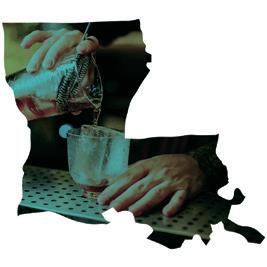
as most people think). The name Rockefeller adds a hint of excess.

Prior to my first raw oyster I would put the glob on a saltine and douse it with ketchup, horseradish and lemon juice. When chomped into, it did not taste like an oyster at all but rather like an overloaded cracker.
But we all face those moments in life when we have to take the next big step, like the first time riding a rollercoaster. Standing at an oyster bar I bravely stabbed the glob with a cocktail fork and then, while shunning the usual add-ons, targeted it to my mouth. There was a moment’s pause, and then the verdict. “This is pretty good, I think I will have another.” There are many varieties of oysters but among the very best is the East Coast Gulf oyster which at its best is salty, chubby and chilled. Soon I was asking for more faster than the shucker could shuck.
I have a neighbor who is in his upper 40s. Each year on his birthday he eats oysters equaling the number of his new age. He sets up a table on his front lawn alongside a chest of beer where other neighbors partake too but not to the extent of the celebrant. Hitting the targeted quantity is an achievement reserved for him alone.
If it is true, as the oyster industry promotes, “Eat Oysters, Love Longer,” he has a lot to live for.
Vieux Carré – The Cocktail and the Neighborhood
According to legend, the original cocktail was invented in an apothecary in New Orleans’ Vieux Carré. The neighborhood, is such a watering hole for classic drinks it seems only right that there would be an actual cocktail named the Vieux Carré. Though less known than other mixed drinks, it is now having a revival! Guest: Author
John DeMers
EPISODE 127
The Disease – One Man’s Journey Through a Life with Leprosy
Officially known as “Hansen’s disease” but the world recognizes the jarring, more familiar term “leprosy.” A place in south Louisiana known as Carville was, along with a facility in Hawaii, the national center for the care of patients with the disease. Author Anne Harmon Brett tells her moving story of being raised by parents who first met at Carville. Guest: Author Anne Harmon Brett
Tales of the Crawfish
Sam Irwin, the author of the book “Louisiana Crawfish: A Succulent History of the Cajun Crustacean" tells tales of crawfish including the impact that the critters had on the rice industry, the most productive growing areas and the ongoing debate over “sucking the heads.”
Guest: Author Sam Irwin



WRITER

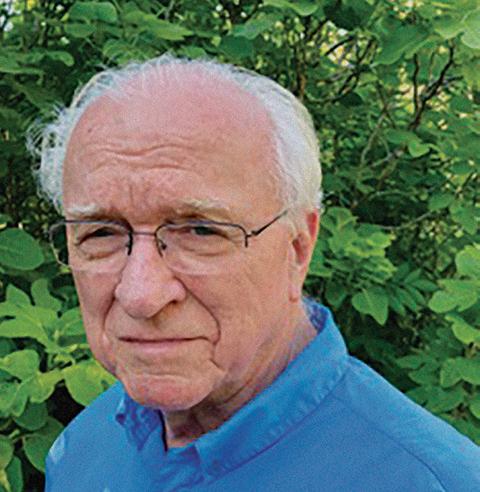
WRITER
Jeffrey Roedel is a producer, director and journalist focused on Southern makers, artists and creative thought. A graduate of LSU and the University of Southern California’s Production Workshop, he’s the former editor of 225 in Baton Rouge. In 2020, he released a collection of mantras for creativity called “Life Is Gonna Try to Put a Lot of Polo Shirts on You.” His album of pandemic poetry and music called “Distance” was released in 2021. WRITER

Kevin Rabalais, an Avoyelles Parish native, writes and photographs the Natural State series for Louisiana Life. After living for more than a decade in Europe and the South Pacific, he is excited to be back home and to document diverse Louisiana stories. His work has appeared in 64 Parishes, The Australian, the New Zealand Listener, and the Argentine magazine Revista Ñ. He teaches in the Department of English at Loyola University New Orleans.
Cheré Dastugue Coen is a food and travel writer, photographer and author and owner of the whimsical blog, “Weird, Wacky & Wild South.” Her fiction includes two series of Louisiana romances and the “Viola Valentine” paranormal mystery series under the pen name of Cherie Claire. Coen remains passionate about her home state of Louisiana, believing that gumbo, crawfish étouffée and chicory coffee makes all things right with the world.


FOOD WRITER
Stanley Dry writes the “Kitchen Gourmet” column for Louisiana Life magazine and is author of “The Essential Louisiana Cookbook” and “The Essential Louisiana Seafood Cookbook” and co-author of “Gulf South.” Formerly senior editor of Food & Wine and founding editor of Louisiana Cookin’ magazine, his articles have appeared in Food & Wine, Travel & Leisure, The New York Times, The New York Times Book Review, Boston Magazine and Acadiana Profile, among others.
FOOD PHOTOGRAPHER
Eugenia Uhl’s photographs have been featured in New Orleans Magazine, New Orleans Homes & Lifestyles, Southern Accents, Metropolitan Home, GQ Magazine, Essence, Travel & Leisure and Vegetarian Times. Her clients include Ralph Brennan Restaurant Group, International House Hotel, Volunteers of America, Galatoire’s and Tulane University. She has completed multiple cookbooks, including Commander’s Kitchen for Commander’s Palace and New Orleans Home Cooking by Dale Curry, Pelican Publishing.


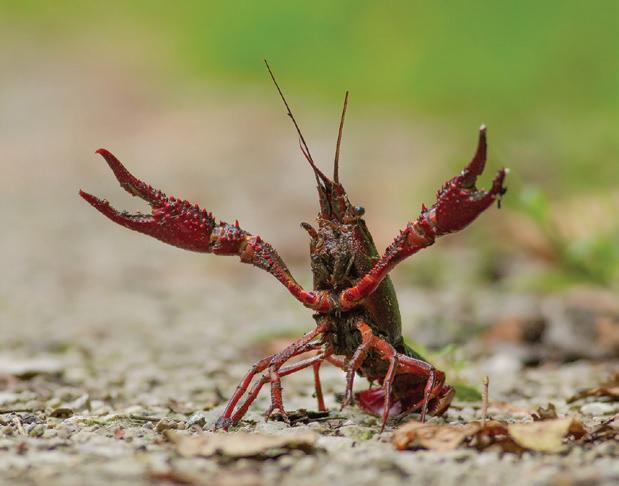


Don’t miss the beautiful 26th annual Coushatta Powwow, held June 9-10 at the Coushatta Casino Resort, celebrating Native American culture with tribal costumes, dancers, live music, food, artwork, vendors and demonstrations plus contests that include singing, drumming, shawl designs and basketmaking (coushattapowwow.com).
METAIRIE
A TikTok Nutria Tale
Neuty, the 22-pound TikTok celebrity nutria (a Metairie family’s beloved house pet for the past two years since rescued in infancy) was set to be removed by officials and moved to the Baton Rouge Zoo. After more than 17,000 folks signed an online “Free Neuty” petition, the state has decided to allow Neuty to remain at home, pending finalization of permits. Meanwhile, the plump and playful Neuty is enjoying eating crawfish and riding in cars (tiktok.com/@neutythenutria).

PINEVILLE, NEW ORLEANS
Starry Waffle Night
A painting of Waffle House in the style of Vincent van Gogh’s "Starry Night" has gone viral on social media. Waffle House’s Instagram also complimented the painting. The original artwork by Pineville native Matt Dawson (a pharmacist by day and a self-taught avocational artist for the past 30 years) has already been sold, but his prints are available on Etsy. For those interested in seeing the real thing, the Van Gogh Immersive Experience continues in New Orleans until May (vangoghexpo.com/neworleans).
BATON ROUGE
Head to the 2nd annual Bogalusa Balloon Festival (June 2-4) at George R. Carr Memorial Airfield to see hot air balloons flown by pilots from across the region with special events during the week leading up to the festival. Enjoy live music, crafts and a carnival with rides, food and games (louisiananorthshore.com/event/bogalusa-balloon-festival/5215).
The LSU School of Veterinary Medicine (the only veterinary school in Louisiana) announced an initial $2.2 million state investment that is designed to propel the goal of almost doubling admissions by next year. Increased admissions will also help sustain Louisiana’s thriving horse industry estimated at over $2 billion (lsu.edu).


Cocktail lovers, artists and libertines, historians and history makers have long been obsessed with The Green Fairy, the colorful name for the licorice-flavored liquor absinthe. Its powerful mind-altering punch has been felt from the streets of Paris to cafés in Prague and beyond, and locally in barrooms across New Orleans. Author Marielle Songy has put together the latest in the “Iconic New Orleans Cocktails” series exploring one of the Crescent City’s most mysterious drinks, the Absinthe Frappé. Songy details the cocktail’s creation and its creator, bartender Cayetano Ferrér, plus gives readers a look at the history of absinthe in New Orleans, its worldwide ban and the lifting of restrictions thanks, in great part, to a local enthusiast. Hardcover, 138 pages, $19.95
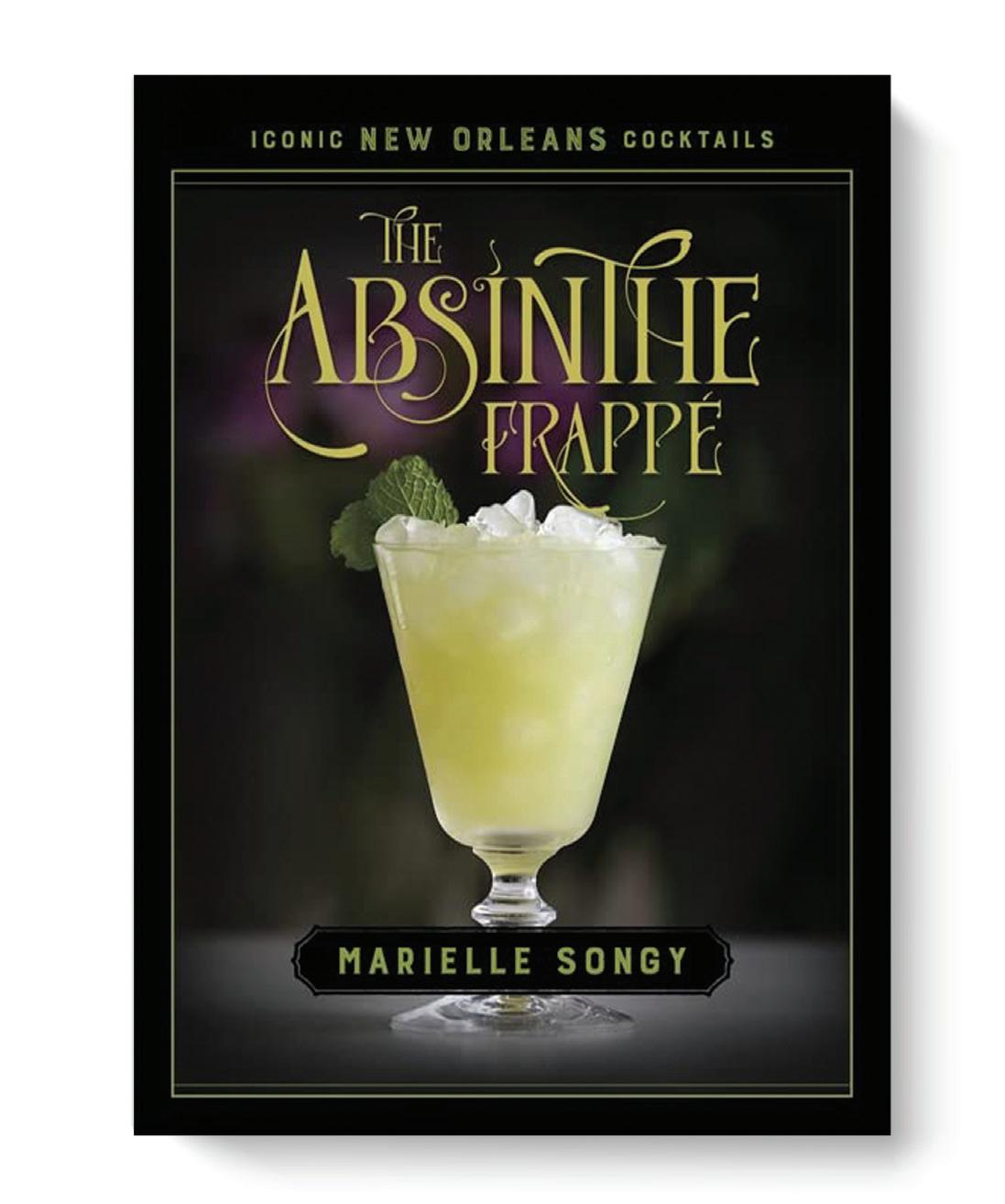
Writer, historian and geographer Richard Campanella’s latest book, “Draining New Orleans: The 300-Year Quest to Dewater the Crescent City” tackles one of the most perplexing, frustrating and essential questions that has plagued the city since almost its very beginning. The book deftly takes on the broad, but essential, questions of geography, public health, engineering, architecture, politics, race relations and more. Dubbed “the world’s toughest drainage problem,” “Draining New Orleans” is a vibrant look back and ahead at challenges the city has faced and continues to take on as it moves forward in a world of climate changes and political upheaval. Hardcover, 424 pages, $39.95

Kingfish U: Huey Long and LSU

Many might argue that you can’t talk about the history of the state of Louisiana without talking about Louisiana State University and Governor Huey P. Long. The two figures go hand in hand, evolving together to become iconic institutions with long-lasting legacies that continue today. In “Kingfish U: Huey Long and LSU” by writer and Manship Chair in Journalism at the Manship School of Mass Communication at LSU, Robert Mann, the evolution of the politician and the (then) small state school into powerhouses of influence are recounted in all their historic glory. Long made it his mission to transform LSU into a university of note, expanding not only its academic profile and enrollment, but making its band and burgeoning football program into a mainstay on the national athletic stage, even penning the fight song “Touchdown for LSU.” Part biographical chronical, part boisterous tale, “Kingfish U” is a must read for LSU enthusiasts, history buffs or those that just love Louisiana and a great story. Hardcover, 352 pages, $34.95
In “With Hawks and Angels: Episodes from a Southern Life,” writer Joel Lafayette Fletcher, III has penned an immensely personal account of an evolving life. From his childhood immersed in Cajun country to his college years at Tulane in New Orleans, his time traveling the world with the Navy and to his coming to terms with coming out, Fletcher’s story is a moving and triumphant account of growing up and growing out of established norms while embracing your true self. Hardcover, 219 pages, $30

A roundup of books to keep you reading until summer really kicks in
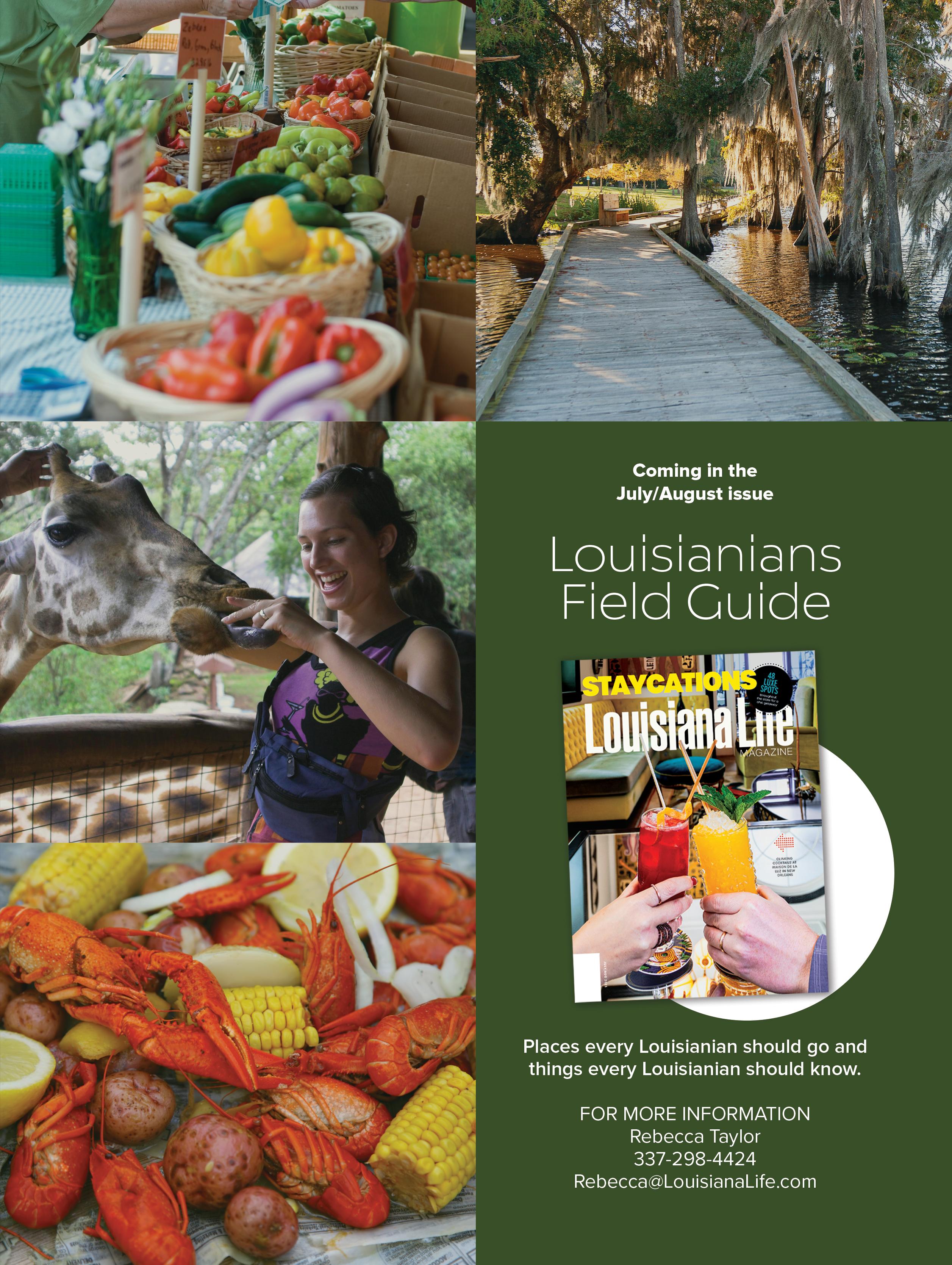

 BY JEFFREY ROEDEL PHOTOS BY ROMERO & ROMERO
BY JEFFREY ROEDEL PHOTOS BY ROMERO & ROMERO
Fast currents, rocky obstacles and significant drops are likely. Sudden maneuvers required. Such hazards of entrepreneurship have their equals in Class 4 rapids, and whitewater fitting this description was all too common while a 19-year-old Jordan Rose navigated the Tuckasegee River. For a couple summers in college things got intense on the water while he led wilderness therapy classes for children with autism outside of Hendersonville, North Carolina.
The resourceful Arkansas native logged about 300 miles by canoe with the children, but the real arrival was finding himself.
“I think I learned how to communicate, how to really connect,” says Rose, now the co-founder and CEO of GoodWood Nola, a custom furniture and architectural fabrication firm in New Orleans. “Those parents trusted me with their kids to navigate down the river, and I carry that confidence even now into everything we make.”
Before even glimpsing the door of the shop, a small structure springs out from the gray gravel crunch of the parking lot surrounding an otherwise nondescript red brick warehouse in a central part of the city. It’s a Krewe tiny house, one of a dozen trailer-sized mobile shops GoodWood Nola has custom built for the New Orleans-based eyewear brand and delivered across the country — including to Austin, Dallas and Nashville.
Meticulously crafted tables, bar tops, shelving systems and complete commercial build-outs for the hospitality industry are their specialties, but it is flexibility and innovation on projects like these creative retail outlets for Krewe and pivoting to fabricating 100,000 medical face shields during COVID-19 that define the strength of Rose and his team as specialty contractors.
Launched by Rose and a couple of friends in 2014 after successful shelving projects for New Orleans-based businesses District Donuts, Sliders & Brew and Dirty Coast, GoodWood Nola is now a family affair with Rose as the lone remaining founder operating the shop, his wife Maggie managing the books and staffing, and a small team of woodworkers, welders and painters on the production line.
“I wanted a space that’s efficient,” Rose says walking the floor and overseeing operations that once took place in a garage. “I love having architects and interior designers here so they can see our capabilities, that we are legit.”
Today the team is working on pieces for an ambitious front-of-house renovation at Emeril’s in New Orleans aimed at boosting a vibrant and casual happy hour for the venerable eatery, as well as a range of unique furniture — including a massive dish storage unit — for the home of Melissa Martin, the founder and celebrated chef behind Mosquito Supper Club in New Orleans.
Deliberately abstaining from the automotive finishes — and some 150,000-plus colors — he can use, GoodWood Nola’s pieces for Martin are being built and hand-painted with earth tones, leaving the visceral streaks of brushstrokes for a rustic feel like Paw-Paw might have done on the back porch.

“Some subcontractors have bad reputations of ghosting people, so we reply to every email and really focus on being responsive and intentional every step of the process,” Rose says.
AGE 32
LOCATION
New Orleans, LA
OCCUPATION
Co-owner/Co-founder, GoodWood Nola

WEB
goodwoodnola.com
As they grow with projects across the country, GoodWood Nola remains focused in heart on its home. Rose contributes to urban reforesting programs like SOUL (Sustaining Our Urban Landscape), and in 2019, the company was recognized as “Best In Show” at the Love Your City awards for prioritizing sustainable development.
Rose sources as much wood as possible from sustainable sources in Louisiana and along the Gulf Coast.
What are some of your favorite places to hang out in Nola when y’all have free time?
Maggie and I like to take our daughter to the zoo or walk around Audubon Park. If it’s just the two us we will enjoy a night out at Jack Rose and catch some live music on Frenchmen Street.
What’s the most unique thing GoodWood Nola has made lately? The most unique thing we have made would be the donor wall for Second Harvest Food Bank. This project was a sculptural art piece we built to honor those who have contributed to the food bank.
You mentioned the name GoodWood Nola might not be the name you would choose if you were starting the company today. What would you call it if you started in 2023? Great question! I would likely just go with my last name and call it Rose Design and Build.
If you could work with any brand, celebrity or client globally, who would it be, and what specifically would you love to make for them? I’d love to work with SpaceX to make space furniture! They are going to need tables on Mars.
All his sawdust is sent to a farm on the North Shore, mostly for bedding their chicken coops.
As energy for restaurant growth and nightlife in New Orleans ramps up on the back side of the pandemic, Rose is content with the size of his team and volume of GoodWood Nola’s work. But he’s always excited about the next bid, the next challenge, particularly with the larger commercial jobs now coming his way like work with L’Auberge Casino Hotel.

“Our jobs are so varied and so custom,” Rose says. “It’s often a balance of what the client dreams up versus what is actually possible physically, and meeting in the middle with a build that is beautiful.”


After stints making props for feature films in Shreveport and designing displays at the World War II Museum in New Orleans, Rose has found a groove, navigating the obstacles of a unique career as a creative entrepreneur. Though he’s firmly set on leading GoodWood Nola into its second decade of building furniture and strong relationships with contractors, his distant plan could include something humble but mountainous — perhaps relocating his family to North Carolina, where he once canoed all summer long.
“My retirement plan is running a hardware store, the kind with free popcorn and coffee,” Rose says with all sincerity. “Just helping people and answering questions up in the mountains.” n

Renowned photographer Carol Highsmith partners with Louisiana Public Broadcasting for book to accompany TV documentary
 BY JOHN R. KEMP
BY JOHN R. KEMP
Astatement by the internationally acclaimed documentary photographer Carol Highsmith sets the tone for Louisiana Public Broadcasting’s recent four-hour TV documentary and Highsmith’s companion book exploring the people, towns, cities, customs and landscape across Louisiana today: "There are a lot of wonderful places in this country," says Highsmith. "But you’ve got a state that is absolutely amazing."
She says Louisiana just stands apart. "I’ve traveled to Siberia, Russia, China, all of Europe many times, there’s America and then there is Louisiana," says Highsmith. "If someone closed your eyes and brought you into
Louisiana, you’d wonder if you were in America. But it is America with American touches to it.”

According to Louisiana Public Broadcasting, or LPB, executive producer Linda Midgett, the documentary project began in 2021 when former Lieutenant Governor Jay Dardenne and LPB decided to produce a TV series about Louisiana then and now, based on a popular lecture Dardenne has given widely over the last 20 years or so. The former lieutenant governor, secretary of state and state senator and now the commissioner of the Division of Administration under Governor John Bel Edwards wrote the script and narrated the lighthearted and highly enter-

taining TV documentary and somewhat travelogue bearing the delightful title, “Why Louisiana Ain’t Mississippi … or Any Place Else!”
Early in the project, a friend contacted Midgett at LPB and told her about the documentary photographer Carol Highsmith who over the last 40-plus years has photographed all 48 lower states, from which she has published seven books with more to come. After seeing Highsmith’s books, Midgett and the folks at LPB thought a photographic book about Louisiana would be a perfect companion to the documentary, not to mention a great gift for new LPB members.
Highsmith, a graduate of the Corcoran School of the Arts & Design in Washington D.C., says she welcomed the opportunity to visit Louisiana again. She had been here many times over the last 40 years. Now working with LPB, she and her husband, who also own a publishing company, flew down from their home outside Washington, D.C., in February 2022 to photograph Mardi
CAJUN

John Isiah Walton
Paintings by New Orleans artist John Isiah Walton, through May 13. Acadiana Center for the Arts, Lafayette. acadianacenterforthearts.org
CENTRAL Environmental Impact II
Traveling exhibit focused on environmental issues, March 4 through June 18. Alexandria Museum of Art. themuseum.org
Pinpointing the Stars
Works from the permanent collection, highlighting planetarium’s history, through Aug. 1, 2024. Louisiana Art & Science Museum, Baton Rouge. lasm.org
NOLA Monochromes: Japanese Zen Paintings and Ceramics
Historic Zen paintings and contemporary ceramics, through June 4. New Orleans Museum of Art. noma.org
NORTH A. Hayes Town. Historic designs by the famous Louisiana architect, May 25 through Aug. 5. Masur Museum of Art, Monroe. masurmuseum.org
Gras festivities in Baton Rouge, New Orleans and Mamou. They returned that summer and spent several “terribly hot” months traveling across the state, photographing places, people and events suggested by Dardenne and LPB staff.
“We went everywhere,” says Highsmith. “I’ve crossed the United States for 43 years and I’m telling you, doing a book on Louisiana was probably the highlight of my life. With Jay’s guidance I really saw Louisiana. I love it even more.”

Within three months — a remarkable speed, — Highsmith produced and delivered to LPB the 256-page, full-color, hardcover book, bearing the same title as the documentary, “Why Louisiana Ain’t Mississippi … or Any Place Else!” Hundreds of photographs cover everything from Clementine Hunter’s cabin at Melrose Plantation in Natchitoches Parish to a shrimp boat plying Bayou Dularge and the “Soul Queen of New Orleans,” Irma Thomas.
“Carol’s photographs are stunning,” says Midgett. “They capture the diversity of the state and all of the regions. Only Carol could come down here with no notice and pull this off.”

In addition to narrating the documentary, Dardenne wrote the book’s introduction and captions for the photographs. In his engaging overview of Louisiana, Dardenne puts neighboring Mississippians at ease. The title, he writes, is “not a knock on our neighbor. It’s just a recognition that our unique blend of religious zeal and ‘joie de vivre’ exists nowhere else in America.”
Visitors to Louisiana, he goes on to say, “are inherently drawn to our state for its lush scenery, its recreational medley, its food, its festivals, the Mardi Gras, Jazz Fest, and its ‘laissez les bons temps rouler’ (let the good times roll) attitude. Louisiana’s penchant for preservation and the resilience in the face of adversity, usually wrought by Mother Nature’s wrath, are well recognized. The state has made contributions to American art, literature, athletics, music and politics disproportionate to its relatively small size.”
Until further notice, however, the book can only be obtained by joining LPB. It may be in bookstores next year.
Highsmith’s work for LPB is the latest in a remarkable career. To date, she has photographed every state in the Union except Alaska and Hawaii, which she will do this year. She also has photographed, among other places, Washington, D.C.’s famous Willard Hotel before and after restoration, as well as the revitalization of historic buildings along Pennsylvania Avenue. So far, she has given her sponsor, the Library of Congress, about 75,000
copyright-free photographs of America with more to come, including the 3,000 images taken for the LPB project. Her collection at the library is the most extensive look at America since the Great Depression when the Farm Security Administration sent photographers, such as Dorothea Lange, out across America to document hard times.
“Carol has made a remarkable contribution to America by giving the public unfettered access to her images of our great land,” says Dardenne. “Linda Midgett and I jumped at the opportunity to collaborate with her on the LPB documentary to ensure that we left a legacy in both film and print.”
Describing her growing collection at the Library of Congress, Highsmith says it’s not a “legacy about me, it’s a legacy about us.”
Regarding her travels across Louisiana, she again reminds us “there are a lot of wonderful places in this country,” but Louisiana is “absolutely amazing.” For more information, visit lpb.org. n



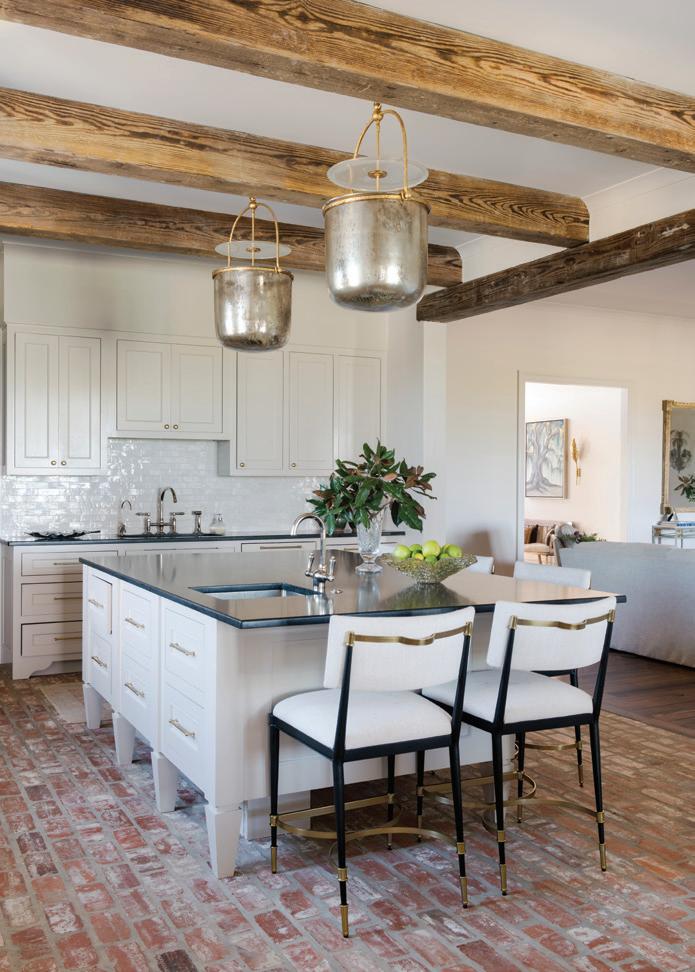 BY LEE CUTRONE PHOTOS BY HAYLEI SMITH
BY LEE CUTRONE PHOTOS BY HAYLEI SMITH
Vernacular architecture is a traditional form of building reflecting local environmental influences, using locally available building materials and is passed down from generation to generation — exactly what Lauren and Logan Lemoine had in mind when they built “a new old house” with a strong sense of place in Cheneyville. The couple share an abiding affection for the Bayou State. Lauren, a psychologist, is originally from New Orleans. Logan, a Marine Corps veteran and third-generation farmer, who now runs the family’s 4L Farms, grew up in Bunkie. With marriage and a blended family that includes William, 10, and Evangeline, 8, the Lemoines wanted a house to accommodate their new life and pay homage to their surroundings.
“We always said if we were going to build, we would like to build on the farm,” says Lauren of the site they purchased from Logan’s brother. “We both love Louisiana so much, so it was kind of cool to be able to build a house that reflected that.”
The property’s 4.5 acres are surrounded by sugarcane much of the year (the farm also grows soy bean, crawfish and wheat) and is situated across the road from Bayou Boeuf, a picturesque wetland teeming with wildlife. For advice on building a house that fit in with the landscape, the Lemoines consulted Lauren’s friend Megan Lord, an Alexandria shop owner and preservationist. Lord put together detailed information on the historically-rich area’s 19th-century Greek Revival architecture (Cheneyville was founded in 1811) — from window styles to baseboard heights — and suggested period
 Lauren, pictured with her dog, Beignet, found the study's French door at Jim’s Antique Doors & More in Rayne. Desk, Fireside Antiques; chair, Facebook Marketplace; painting, Tony Forrest.
Lauren, pictured with her dog, Beignet, found the study's French door at Jim’s Antique Doors & More in Rayne. Desk, Fireside Antiques; chair, Facebook Marketplace; painting, Tony Forrest.
materials, such as cypress doors. The Lemoines had plans drafted for a a Planter's Cottage, a simplified version of a Greek Revival cottage. The plans were also informed by both Lauren’s love of A. Hays Town architecture and Logan’s appreciation of the outdoors.
“It took so much guesswork out of [building] and helped with the decision making,” says Lauren. “We had a clear vision and felt very prepared.”
Classic architectural elements such as wood floors, weathered ceiling beams and French doors impart an “old and indigenous” aesthetic, while the absence of

formal living and dining rooms and the open layout of the kitchen and central living space modify the traditional underpinnings of the house for the way young families live today.
Lauren made an effort to buy local and searched online for reclaimed materials from across the state. She found six antique cypress doors, as well as the living room’s antique cypress fireplace mantel, and stripped most of them herself. She also visited antique stores and galleries from Baton Rouge to Alexandria for furnishings, local art and other treasures, and ordered custom pieces from
artisans such as Doorman Designs, Kathy Slater Designs and Julie Neill Designs, all in New Orleans.


Several of the home’s standout features came from historic properties being demolished. The bricks used for the kitchen floor and the outdoor kitchen (a mandate from Logan who loves to cook and boil crawfish) came from an old Lecompte sugar mill and the rustic antique cypress used on the roof of the foyer and for the garden fence outside from a circa 1830s plantation house being razed in Ascension Parish. The tin used for the ceiling of the outdoor kitchen was salvaged from Logan’s grand-
AT A GLANCE
INTERIOR DESIGN
Patti Hemingway
BUILDER
Shane Dauzat
SQUARE FOOTAGE
3,000
OUTSTANDING FEATURES
Reclaimed materials (cypress doors, brick, tin, hardware).
ARCHITECTURAL FEATURES INSPIRED BY LOCAL GREEK REVIVAL HOUSES
six over six windows, French doors, center hall, antique fireplace.
father’s barn. In addition to having the patina of age, reclaimed materials had the benefit of being immediately available.
“COVID presented a whole set of problems with supply delays,” says Logan, recalling a long wait for replacement tiles broken during shipping. “It made us plan it out a little better, and order things ahead of time.”
Working with builder Shane Dauzat (Lauren knew he was the builder for the project when she walked into his office and saw the same A. Hays Town book she pored over as a child in her parents’ home) and Houston-based interior designer Patti Hemingway, who’d also worked on Lauren’s parents’ residences, the Lemoines broke ground in summer of ’21 and moved in the following spring. On the front porch, a pair of cypress pedestals flank a traditional front door with vintage-style, rice-pattern hardware. Grisaille wallpaper enlarges the powder room with boundless views of marsh. A custom shower curtain with a palmetto motif in the children's bathroom mimics saw palmettos. But Lauren, who prefers a mix of old and new, made sure to also add something modern or whimsical in every room. Hemingway found the fourpiece marble coffee table with midcentury modern lines for the living room and Lauren sourced the Julie Neill glass chandelier that looks like a bundle of bubbles in the office and guest room.
The children are especially fond of the rural setting that inspired the design of their Central Louisiana homestead.
“We all have our own spaces to do things," says Logan."But they really love playing outdoors,”■
(Left) Bed, Doorman Designs; painting, by Leah Morace of Alexandria. (Right) William’s bed is a family heirloom handed down through Logan’s family. The embroidered wildlife above the bed was found on Facebook Marketplace.If ever there was an optimum time to become a vegetarian, it is now. With all the fresh local produce available this month, a person could make the change and not feel at all deprived. A visit to the farmers market is an exercise in excess: Tables overflowing with tomatoes, cucumbers, sweet corn, zucchini, summer squash, beets, leeks, arugula, new potatoes, green beans, wax beans, radishes, bell peppers, eggplant, blueberries, blackberries — and that’s just for starters. Everything is so beautiful and fresh that it’s almost impossible not to buy more than you really need.
Someone once suggested that the best way to deal with so much produce is to start preparing and cooking as
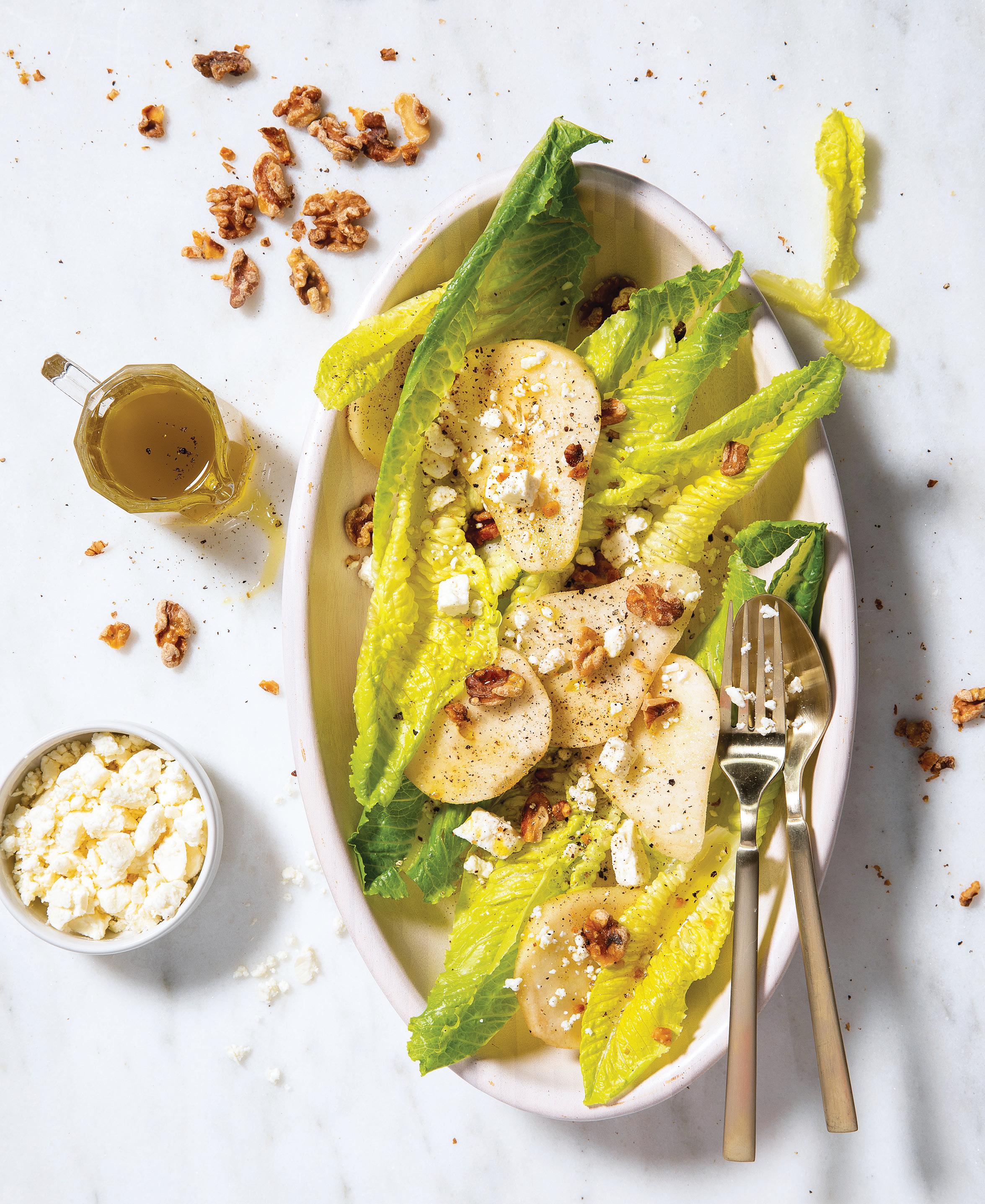
½ cup walnuts
1 romaine lettuce
¼ cup extra virgin olive oil
4 teaspoons white wine vinegar
coarse salt
1 pear
½ cup feta, crumbled freshly ground black pepper
TOAST walnuts in a dry skillet over medium heat, while tossing and turning them, until fragrant. Remove from skillet, sprinkle with salt and set aside.
CUT lettuce from its base, discarding limp or bruised leaves. Wash and dry romaine. Tear leaves and add to salad bowl. In a small bowl, whisk olive oil and white wine vinegar until emulsified. Add half of the vinaigrette to salad bowl and toss to coat lettuce. Season with salt and toss again. Peel, core and slice pear. Arrange pear slices on top of salad and top with feta. Drizzle remainder of vinaigrette over pears and cheese. Sprinkle walnuts and grind some black pepper over the salad. Makes 4 servings.
1½ cups water
¾ cup sugar
6 quarter-size slices of fresh ginger, peeled
3 tablespoons fresh squeezed lime juice
3 cups blackberries
COMBINE water, sugar and ginger in a saucepan. Bring to a boil and boil for 5 minutes. Cool. Add lime juice.
COMBINE blackberries and syrup in a bowl. Cover and chill. Makes 4 servings.
Grab locally grown goodies and make these easy summer salads and soups
soon as you return from the market. If you can do that, you’re likely to find that you’ve reduced waste and made life easier in the coming week. For instance, if you’ve bought green beans, trim and blanch them, cool them under running cold water or in an ice bath, then dry them, wrap them in a clean kitchen towel and refrigerate. Now they’re ready to add to a salad or sauté in butter for dinner.
Try turning some vegetables into cold soups, such as a curried zucchini soup. Keep it in the fridge and you’ll have an instant snack or light meal. For soups that are finished with milk, cream, sour cream or yogurt, don’t add the dairy until you’re ready to serve it.
Those who love cold food in the summer, as I do, can cook vegetables ahead and keep them in the refrigerator. If you roast beets and poach asparagus ahead of time, for instance, it takes almost no time at all to turn them into salads.
If you’ve bought some new potatoes, boil them and keep them in the fridge to make a quick batch of home fries. Or use them to make a niçoise salad in combination with the green beans you’ve already blanched, hard boiled eggs, tuna, anchovies, black olives and tomatoes on a bed of lettuce.
All of the recipes this month are a cinch to make. After all, if you have good ingredients, the cook’s work is mostly done. You can prepare several of the recipes without even turning on the stove, and the others only require minimal cooking.n
4 cups loosely packed arugula
2 tablespoons extra virgin olive oil
2 teaspoons balsamic vinegar
coarse salt and freshly ground black pepper
Italian Parmesan (ParmigianoReggiano)
COMBINE arugula, oil, vinegar, salt and pepper to taste in salad bowl and toss well to coat. Arrange salad on serving plates. Using a vegetable peeler, shave thin slices of Parmesan over the tops. Makes 4 servings.
6 cups chicken stock or broth
1 large onion, chopped
1 large potato, peeled and cubed
1 bunch watercress
coarse salt
½ cup heavy cream
1 tablespoon chives, chopped
COMBINE chicken stock or broth, onion and potato in a pot and boil until onion and potato are tender, about 15 minutes. Remove from heat. Cut and discard the bottom ½-inch of watercress stems. Coarsely chop remainder of watercress and add to the pot. Purée with an immersion blender or, working in batches, purée contents in a standard blender until smooth. Season to taste with salt. Chill. Before serving, adjust seasoning. Whip cream until soft peaks form. Ladle soup into bowls and top with a dollop of whipped cream. Sprinkle with chopped chives. Makes about 6-7 cups.
1-1½ pounds beets
2 tablespoons extra-virgin olive oil
1 tablespoon white wine vinegar coarse salt and freshly ground black pepper
1 tablespoon chives, chopped
1 tablespoon parsley, chopped
PREHEAT oven to 375 F. Cut greens from beets, leaving about one inch of stem. Reserve greens for another use. Wash beets and wrap individually in aluminum foil. Place foil packets on baking sheet and bake in oven until a toothpick or the point of a small knife pierces them easily, about 30-60 minutes, depending on size of beets. Remove from oven and cool.
WHISK oil and vinegar together in a mixing bowl. Peel beets and slice or cut into wedges, as desired. Toss beets in vinaigrette and arrange on serving plates. Season to taste with salt and pepper and sprinkle with chives and parsley. Makes 4 servings.

This is probably the easiest soup on the planet to make, and it is very refreshing on a hot day.
3 cups chicken stock or broth
3 large cucumbers, peeled and sliced
½ cup plain yogurt
coarse salt
fresh dill
COMBINE chicken stock or broth, cucumbers and yogurt in a mixing bowl and purée with an immersion blender. Or, working in batches, purée chicken stock or broth, cucumbers and yogurt in a standard blender and until smooth. Season to taste with salt. Chill. Serve cold garnished with chopped fresh dill. Makes about 6 cups.

An oyster reef restoration program provides storm protection, rebuilds marine habitats, generally improves the ecosystem and restores hope for future generations

Across the aisle, Belle Chasse native Leslie Pickles leans forward. “My home is important,” she says. Heads nod among the dozen others — families, couples and students — on today’s tour, and for a moment, Pickles’ answer lingers. It’s pregnant with meaning: Home as four walls and a roof, yes, but also home as culture, home as the place where we attune ourselves to the cadence of life and where landscape forges our understanding of the world — home, where we listen, as Barry Lopez writes, “for the voice of memory over the land.”
With the increasing frequency and intensity of tropical storms and hurricanes, it’s understandable that many in Louisiana have adopted— or, in some cases, inherited — a fatalistic outlook that leads us to live in the moment. Curse storms. Praise Carnival. Each provides an annual reminder of life’s precariousness and impermanence. To live in South Louisiana and understand what’s happening to our coast means to maintain a firm grasp of both.
Take a moment to picture our state as it appears on maps. Follow the coast from west to east. Let your eyes linger over the bird foot delta until it unfurls, with a flourish, into the Gulf of Mexico. That’s the Louisiana that we think we know. But today’s satellite images reveal a landmass unlike the one you remember from maps in your grandparents’ homes. What these images show, rather — and these words catch in the throat — is a far sicklier version than the one we hold close, in memory.
While knowledge of wetlands loss in Louisiana lurks at the back of our collective psyche, the numbers remain difficult to fathom. Consider the July 2017 report from the United States Geological Survey (USGS). For many naturalists, conservationists and scientists, the statement has become standard: Each hour, on average, a football field’s worth of wetlands vanishes from Louisiana’s coast. And that, noted the USGS, showed signs of improvement because it followed a “lack of major hurricanes” in the previous eight years. Since then, however, storms whose legacies will pass through generations like unwanted heirlooms, among them Harvey, Laura, Delta, Zeta and Ida, have battered our coast.

On LA Highway 46 in Violet, headed south to the Coalition to Restore Coastal Louisiana headquarters, a student seated at the back of the bus poses a question: “Is restoration important?” It’s simple but not simplistic, a reminder that starting at the beginning often provides our best chance for meaningful conversation. And this conversation is urgent.CRCL staff and volunteers constructed this reef in Adams Bay from oysters collected in the recycling program. This work now protects a mound built by the AtakapasIshak/Chawasha Tribe. Structures such as this provide habitat for oysters and other marine creatures, including barnacles, shrimp and shore birds

The National Oceanic and Atmospheric Administration reports that half of Louisiana’s 4.6 million residents live in coastal areas. According to the Coalition to Restore Coastal Louisiana (CRCL), between 1932 and 2010, these areas lost an estimated 1,900 square miles of wetlands. That’s an expanse — once there, now gone — approximately the size of Delaware. If we do nothing to stop this loss, CRCL research warns that Louisiana can potentially lose, in the next 50 years, another 700 square miles of wetlands, or a region nearly half the size of Rhode Island. That’s almost twice the size of Dallas and more than two times the size of all five boroughs of New York City.

These wetlands, while significant habitats for fish and wildlife, also provide one of the state’s last lines of defense against storm surges. This is one reason that Darrah Bach, Oyster Shell Recycling Program coordinator at CRCL, responds to that question on the bus — “Is restoration important?” — with an emphatic yes.
“We’re the canary in the coalmine,” says Bach. “Where a lot of places are planning for a future of sea level rise and other climatic forces that scientists are predicting to get worse, in a lot of ways Louisiana has been seeing those changes for almost a century.” As the novelist William Gibson put it, “The future is already here — it’s just not evenly distributed.” Louisiana is ahead of the curve not only on this, however. As Bach says, “We’re lucky because we’ve had ample time to find solutions.”
CRCL research shows that when it comes to the protection of our energy infrastructure, transportation routes and communities, the natural barriers that wetlands provide are as important as floodgates, levees and other man-made structures. “That’s one of the main tenets that we believe in,” says Bach, “and that’s why our restoration program is one of our flagship programs. When storms come in through the Gulf, anything that’s in their way is going to break down their power. Oyster reefs and coastal forests are some of our first lines of defense. The more of them we have before storms reach where people are living, the better protected we are even before those storms reach levees and other man-made structures.”
Founded in 1988, CRCL became Louisiana’s first statewide nonprofit organization dedicated to coastal restoration. Its mission, along with Bach’s infectious enthusiasm for restoration work as a tangible means to protect our coast, should rouse any Louisianian who thinks about home as a place where we carry the memories of those who came before us while making new ones for future generations: “CRCL envisions vibrant wetlands, with hurricane protection, bountiful ecosystems and economic opportunities across Louisiana’s coast.”
In 2000, CRCL started working with volunteers to plant marsh grasses. “This provided an education in the value of building strong natural barriers,” Bach says. “It also showed people that it’s not too late. You hear a lot of fearmongering about this land-loss crisis. But CRCL is evidence that there’s really strong work being done to prevent land loss.”

More recently, CRCL began pursuing ways for other industries to get involved in its restoration work. The organization considered two elements that comprise coastal ecosystems — flora and fauna — and sought support from restaurants. “We have a shell deficit,” Bach says, noting that an estimated 50-80 percent of our natural oyster reef population has been lost. “More shells are being removed from the water than can either naturally regenerate or that are being put back.” As CRCL Communications Director James Karst says, “That’s where the oyster shell recycling program comes in.”
In 2014, in partnership with restaurants, CRCL began its program that

provides a straightforward opportunity for restaurants to engage in healthy, sustainable fisheries and for all of us to play a simple part in protecting Louisiana’s coast.
Follow it like a tracking shot. Fade in as the sun rises over Adams Bay in Plaquemines Parish, where oyster farmers begin raking their beds. The crew fills canvas sacks. By lunchtime, those sacks pile high on the bow of the boat, continuing to grow throughout the afternoon until the captain steers for shore. There, the crew unloads sacks that eventually transfer to a truck that travels to one of the 25 New Orleans-area restaurants that have partnered with CRCL’s Oyster Shell Recycling Program. Later, restaurant staff shuck and arrange those oysters on a platter for patrons to enjoy. Afterward, rather than throw the shells away, as the restaurant once would have done, a staff member empties them into a CRCL-provided bin. The next day or the day after (this happens three, and in some cases five, times a week) a contractor arrives at the restaurant to collect those bins and deliver the shells to CRCL restoration headquarters along the Violet Canal in St. Bernard Parish.
That’s where our bus is headed. From Highway 46, we turn onto a dirt road that leads to a landscape that looks like Falstaff and Gargantua recently held an oyster banquet. CRCL, however, has found a way to remind us that eating oysters is anything but gluttonous. “This is part of our culture,” says Gardner Goodall, Native
Plants Program coordinator. “It’s not something we eat for special occasions. We put oysters on sandwiches.”
Behind Goodall rise several mounds of oyster shells. On top of each perches a wooden hand-painted sign that notes stages in the recycling process. The “cured” sign signifies that shells have been exposed to the elements for six months. “We don’t want to introduce pathogens back into the waters,” Bach explains, noting that vultures also help to clean shells of butter, garlic and other detritus.
Throughout the year, CRCL holds events that bring volunteers to these headquarters. While many volunteers live locally, others arrive from across the country, as do service groups and university classes with service work components. Once at headquarters, volunteers fill mesh bags with 30 pounds of cured shells. When 200 tons of shells have been bagged and stacked at the edge of the oyster field, they’re transferred to what Bach calls “a staging location along a body of water in proximity to a current restoration project.” She continues: “We’ll then have events where volunteers load bags onto boats. They then board boats to the project site and can get out of the boat if they want to and stack bags along banks of a wetlands area.” About that part of the process, Karst says, “It’s almost like stacking LEGOs.”
The shells currently bagged at CRCL headquarters will soon form the second reef of a project in conjunction with the Pointe-au-Chien


Indian Tribe in Terrebonne Parish. Phase one began in the fall of 2022. Soon, volunteers will return to that location with more bags, which will form a reef that protects sacred mounds built by tribal ancestors.
Besides seeing firsthand how this work protects Louisiana’s wetlands, CRCL also reaps other benefits from its oyster shell recycling program. “We’ve seen some of the area in between the bags of shell and the marsh filling in with mud,” Bach says. “This is exactly what we want to witness with this type of work. Having the structure there breaks down waves. It also provides habitat for oysters and other marine creatures such as barnacles, shrimp and shore birds. Oysters also contribute to water filtration. This is one reason that oyster reefs are sometimes called ecosystem engineers. They provide a multitude of services to the area.” Pausing for a moment, her voice rising with excitement, Bach says, “And that’s amazing.”
Less than half an hour’s drive from New Orleans' French Quarter, CRCL’s Violet headquarters opened in 2021 and offers logistical ease for the contractors who several times a week collect those oyster shell-filled bins from participating restaurants. This location also positions CRCL at — again, the words catch in the throat — one of many ground zeroes for storm surges and flooding in Louisiana. This area has already undergone a
worst-case scenario. In his book “The Good Pirates of the Forgotten Bayous,” Louisiana native Ken Wells writes about Hurricane Katrina’s devastation: “The Crescent City was flooded, but St. Bernard was drowned. Saltwater rose 20 feet in some places, and 95 percent of all buildings experienced flooding, most of them catastrophically. It was a deluge of biblical proportions.”
The sustained loss of our wetlands can mean the difference between having a home or being forced to leave it — in the worst case, forever. But Bach and others at CRCL remind us that we don’t have to be fatalistic.
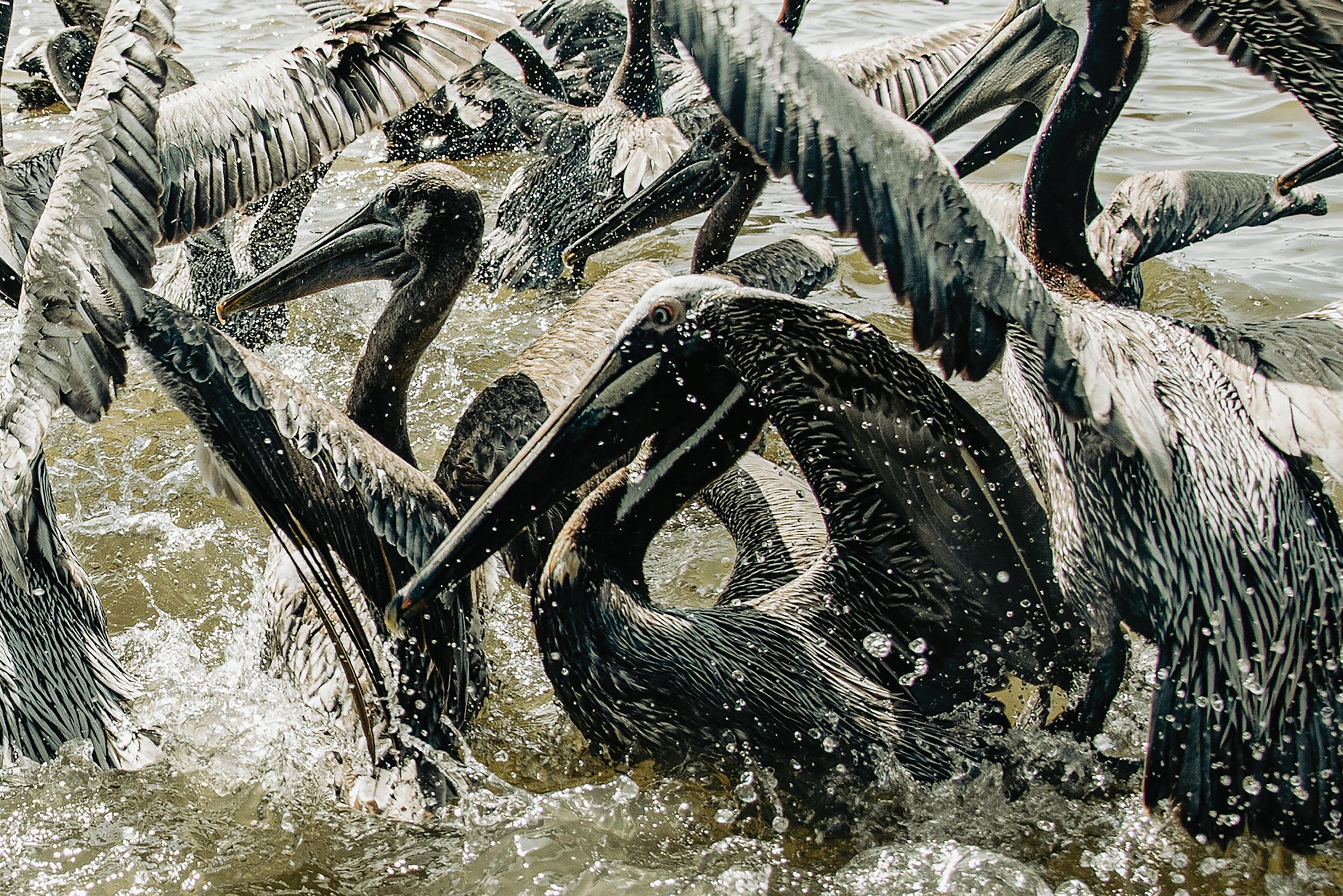
“Since it started, CRCL’s program has put 12.7 million pounds of oyster shells back into Louisiana’s waters,” Bach says. In the two years since its Violet headquarters opened, the program has collected more than 2 million pounds of shells. Soon, volunteers will arrive to bag them. They will use those shells to build reefs. Those reefs will absorb the energy of future storms. They will help protect us.
This work reminds us that to create environmental change, we don’t need to devote every minute of our lives to activism. As Karst says, “We can do something. We can volunteer. We can eat
■

FUN LOUISIANA LOCALES WHERE FUR FAMILY IS WELCOME
 BY CHERÉ COEN
BY CHERÉ COEN
We love our furry friends, so why not take them on the road when we travel? Recent polls show that pet owners want to bring their dogs and cats with them when they travel, which is why many accommodations, attractions and eateries now welcome pets. In fact, around 75 percent of luxury, midscale and economy hotels allow pets, according to a 2016 survey by the American Hotel & Lodging Association.

We’ve compiled a few pet-friendly spots throughout Louisiana where Roux and Minou will feel right at home.
Most Louisiana cities offer national hotel chains such as La Quinta, Hampton Inn and Holiday Inn that welcome pets and that’s just pawsome. Check the different hotel chain websites for more information and additional fees involved.
In New Orleans, several boutique hotels and bed and breakfasts allow for pets. Canopy, for instance, welcomes pets up to 75 pounds with beds, toys and other amenities for a nonrefundable fee. Pets visiting the Hotel Monteleone receive “Monte’s Pet Package” with a fee and per night charge. Ace Hotel greets pets under 25 pounds (and not just dogs) as their guest with a per night charge and the furry members of the family are allowed at the pool lounge.
Baton Rouge’s Hotel Indigo has a 75-pound pet limit and in Central Louisiana, Cheneyville’s historic Loyd Hall Plantation allows pets in their cottages behind the main house. Dogs and cats are welcome at The Remington Suite Hotel & Spa in Shreveport with a fee per pet, per night.

Enjoy one of the 50 beers on tap or indulge in pub fare at the appropriately named The Bulldog Uptown in New Orleans. The Magazine Street patio is the perfect place to relax with your dog and they even have Yappy Hours to raise money for animal charities.
A round of a-paws for downtown Lafayette restaurants that say oui to pets on their outdoor patios. Spoonbill Watering Hole & Restaurant used to be a gas station and tables are scattered out front along historic Jefferson Street. The Wurst Biergarten is dog friendly as well, so pull up a seat in the outdoor space and enjoy food and a cold brew. Closer to the University of Louisiana at Lafayette is the long-standing Olde Tyme Grocery and its patio is a favorite with the dog crowd — that and the trademark po' boys.
Bring a water bowl when you visit Luna Bar & Grill in downtown Lake Charles, which allows dogs on the patio. Over in Baton Rouge, the dog-friendly outdoor patio is the perfect pooch setting at Mid City Beer Garden.
If browsing with the pets is more your style, the Bossier City Farmers Market that’s held from 9 a.m. to 1 p.m. Saturdays at the Pierre Bossier Mall April through November, allows pets on leashes.
With a name like Le Chien Brewing Company (translating from the French to mean "the dog"), you’d expect to see dogs lying about while their owners enjoy a local brew. Ditto for the newly opened Adopted Dog Brewing in Lafayette, which offers a selection of craft beer, food, arcade games and a dog-friendly patio.
Say hello to Tom Petty, the orange and white cat who loves to visit with guests at Crying Eagle Brewing Company in Lake Charles. And hang out with your pet on the courtyard at the brewery’s summer concert series happening through September.

Everyone’s welcome, furry friends included, for beer and pizza at the Cajun Saucer at Bayou Teche Brewing in Arnaudville. But when the weather’s nice, visitors may prefer the outdoor seating.
Flying Heart in West Monroe, Bossier City and Natchitoches love guest pets, although the four-legged visitors may prefer a bowl of water to Flying Heart’s lineup of craft beers. “In Bossier city and West Monroe, we have a dog-friendly beer garden and of course service animals are allowed inside (we had a kangaroo in the other day in Bossier),” said Jeffrey R. Judge, pizzaiolo and director of franchise operations. “In Natchitoches, we currently do not have much available outside space (so very weather dependent) and service animals always allowed. We
When traveling by car, it’s imperative to keep dogs anchored using a seat belt or other means, according to the Humane Society. These safety harnesses keep your dog from jumping in your lap or distracting you while driving but they also protect dogs in the event of a crash. Cats should be kept in carriers while in the car and any kind of pet should remain in the back seat. Never drive with your pet in the back of a pickup truck and don’t leave a pet alone in a car.
Traveling by airplane with a pet may be harmful to the animal, especially if they are flying within the cargo hold, so the Humane Society suggests alternatives, such as traveling by car or leaving them behind in a kennel. If you must bring pets by air, choose having them in the cabin with you, if possible. Always call the airlines before leaving to research their policies.
Service animals are allowed on Amtrak and many European trains allow pets. Cruise ships rarely allow pets, but they do allow service animals; contact the cruise line to discover their pet policies.
One thing to consider when traveling with a cat is that many hotel rooms will have spaces beneath beds. Cats may use these spaces to hide. Ask hotels beforehand and if there are spaces, use pillows and other items to block off access, unless you want to spend an hour digging your feline free. Finally, always bring water and food for your pet when traveling, preferably one that’s easily transportable for use in restaurants and parks. For cats, a kitty litter box is required.

have a dog meal on the menu at all three locations and we do fundraisers with local rescue groups to raise awareness as well.”
That’s just a sampling of the many microbreweries in Louisiana that honor pets.
It’s a given that no matter where you take your dog, they will need to get outside and play. The good news is that Louisiana offers dog parks in nearly every major city.
NOLA City Bark — no, that’s not a misspelling — will delight four-legged friends with its 4.6-acre stretch of fenced lawn with water fountains, shade pavilions, doggie pools and on-site restrooms. Dogs must have a permit showing they are properly vaccinated and spayed or neutered.
There are several dogs parks in Lafayette, including Brown Memorial near Interstate 10 and Girard Park bordering the University of Louisiana at Lafayette. Moncus Park offers both off-leash and on-lease areas, including its newest section, the Giles Automotive Family Small Dog Park. Acadiana Park Nature Station and Trails on the east side of Lafayette features more than six miles of mostly wooded hiking trails, so dogs may enjoy exercise without overheating.
Dogs run free at New Iberia’s Raising Cane's Dog Park and at Kiroli Park in West Monroe. Pooches are separated by size so no bullying is allowed at Alexandria’s Hynson Dog Park. Open daily in Shreveport is another fenced segregated dog park located on the riverfront two miles south of downtown and Baton Rouge offers several off-leash dog parks through their BREC recreation department, open from dawn until dusk.
In Lake Charles, the Lakefront Promenade is a great place to walk dogs on leashes, said Shalisa Roland, director of public relations for Lake Charles tourism. Further south of the city, visitors and dogs may wish for a run near the water. “The Gulf beaches along the Creole Nature Trail are perfect for a doggie daytrip,” said Roland, recommending Holly and Rutherford beaches. “Just bring food, water and poop bags,” she added.
Houmas House owner Kevin Kelly owns a beautiful Labrador named Maggie. She’s one of several dogs that have called Houmas House and Gardens home. Dogs must be on a leash while touring the grounds and if they’re well-behaved may enter the historic home. They’re allowed in the cottage accommodations but only in the outside seating of restaurants.
Jungle Gardens on Avery Island near New Iberia are open to leashed dogs, just
keep a tight rein since the island’s home to lots of gators. The American Rose Center in Shreveport is known for its 20,000 rose bushes since it’s the national headquarters of the American Rose Society. But be sure to "paws" for a picnic with your leashed and properly vaccinated pet while roses bloom from now through mid-October.
New Orleans native Kathleen Walls traveled with her dog Romeo in her RV, and sometimes with her cats, when she owned a motorhome.
“He loved it,” Walls said of Romeo. “Especially if I was in a state park and could take him hiking into the woods.”
All Louisiana State Parks welcome leashed pets into their outdoor facilities, and several parks allow for dogs in cabins for overnight stays. The Park with Pets policy charges $40 per dog with a maximum of two dogs per cabin.
Parks with pets policies for overnight stays include: Bayou Segnette State Park, Bogue Chitto State Park, Chemin-A-Haut State Park, Chicot State Park, Cypremort Point State Park, Fontainebleau State Park (currently closed due to hurricane damage),
Jimmie Davis State Park, Lake Bistineau, Lake Claiborne State Park, Lake D’Arbonne State Park, Lake Fausse Pointe State Park, North Toledo Bend State Park, Palmetto Island State Park, Poverty Point Reservoir State Park, Sam Houston Jones State Park, South Toledo Bend State Park and Tickfaw State Park.
For more information about Louisiana State Parks, visit LaStateParks.com.
It’s Louisiana so you know there will be dog-friendly events to celebrate. The annual Bark in the Park, for instance, is held in November in Girard Park of Lafayette and benefits Acadiana Animal Aid. And, of course, there’s Carnival with its pawsome pet parades. The canine-focused Mystic Krewe of Barkus rolls through a 15-block French Quarter route with a canine royal court, as well as the Krewe des Chiens through downtown Lafayette. Other Carnival pet parades include Baton Rouge’s Mystic Krewe of Mutts, Covington’s Mardi Paws Parade, Lake Charles’ Krewe of Barkus, Monroe’s Krewe of Paws and Shreveport’s Krewe of Barkus and Meoux. ■




The spirited state of Louisiana has no shortage of cultural heritage and scenic locations to explore.
From the Bible Belt’s forested woods to the South’s delectable Creole and Cajun cuisine, Louisiana’s unique blend of Spanish, French, and African American cultures offers a special experience for all travelers! Boasting its vibrant personality, the Pelican State is home to plenty of entertaining escapades, countless family-friendly activities, and soulful music anyone can enjoy!
A scenic outdoor experience, a scrumptious peach, and a good time is what you’ll find in the thriving area of Ruston and Lincoln Parish in North Louisiana! This hidden gem’s cultural heritage shapes its vibrant community and warm hospitality. You’ll feel more than welcome at one of their highlights, the 73rd Annual Louisiana

FPeach Festival! This beloved event brings together the best of Ruston’s homegrown flavors, culture, art, and music for a peachy extravaganza. In the sweet taste of summer, enjoy over twelve hours of live music and plenty of family-filled activities. Not only is Ruston’s Peach Festival known for its delicious array of juicy and succulent peaches, but it also celebrates its vibrant culture and local spirit. Get ready to create cherished memories with friends and family and experience the peachy goodness of Ruston! To learn more, visit lapeachfest.com
Once a part of No Man's Land, Beauregard Parish was a region with no king or country, home to outlaws, bandits, pirates, and brave pioneers. The settlers were larger
than life, and so are the stories! The region's use as an official buffer between Louisiana and Spanish Texas lasted roughly from 1806 until the 1819 Adams-Onis Treaty. Slow to be settled, and marked by a pivotal moment in history, the Neutral Strip region exhibits a culture colored by several pockets of diverse folk groups—like Native Americans, remnants of early Spanish colonies, Scotch Irish pioneers, African Americans, and others—who fiercely hold onto their traditions and notions of identity. Get to know the traditions by attending the Watermelon Festival! Whether you’re looking to dive face first into a mammoth of a watermelon in the watermelon eating contest or show off your adept pageant skills, this festival is perfect
all ages to absorb the local customs! To plan your next visit, visit beauregardtourism.com.
Founded in 1714 and known for being Louisiana’s oldest city, Natchitoches’ rich history set the stage for the cultural city’s hereafter. Now over 300 years later, the City of Lights kicks off the summer with the 26th Annual Jazz and R&B Festival! Scheduled for May 12th and 13th, this special celebration offers a variety of artists’ talents anyone can soak up. Not too far to follow, the Louisiana Sports Hall of Fame Induction is to be held July 27th through the 29th. This noteworthy event highlights and introduces the most deserving Louisiana athletes of 2023. Famous for being home of the movie, Steel Magnolias, Natchitoches bestows the adored filming sites of this classic picture. Also beyond worth the gallivant is the fascinating plantations that each tell a story of their own. They include Melrose on the Cane with the art of Clementine Hunter and the Cane River Creole National Historical Park at Oakland Magnolia Plantations. To plan your next trip, visit natchitoches.com.
Avoyelles Parish, historically established by the Avoyels Indians, inhabits quaint farms and small-town folk. Best known for its agribusiness and rich French background, this region along Louisiana’s Eastern border is notably filled with tales to tell. Their local Civil War Battle Site, Fort Derussy, is home to some of the most invigorating stories proudly absorbed in defending the lower Red River Valley (currently drive by only).
In the upcoming months enjoy local Avoyelles events like the Cajun Crossroads Festival and the Tunica-Biloxi Pow-Wow. If you’re fond of pigs, ingesting or chasing them, take part in the Cochon de Lait Festival (French for roast suckling pig)! Join thousands of visitors taking pleasure in great live music, a pirogue race, peachy dancing, a corn cooking contest, and so much more at the Louisiana Corn Festival. Plan a stop in at Avoyelles Parish and experience the joie de vivre! For more information visit travelavoyelles.com
The mission of the Helis Foundation is to advance access to the arts in New Orleans for all through various initiatives from outdoor sculptures and large-scale murals to complimentary admission days for Louisiana residents at some of our state’s most beloved cultural institutions. In the heart of downtown New Orleans, two of the Foundation’s most prominent public art initiatives – the Poydras Corridor Sculpture Exhibition (PCSE) and Unframed – feature artists of local, national, and international acclaim.
PCSE is the south’s leading rotating sculpture exhibition with over 15 sculptures currently on view along the Corridor. Art Funds of The Helis Foundation have funded the installation of more than 40 sculptures, and Unframed, a project of Arts New Orleans, that has commissioned nine murals to date showcasing the extraordinary talent of celebrated artists including local painter Ayo Scott whose work is prominently displayed on the exterior wall of the Louisiana Endowment for the Humanities, home to The Helis Foundation John Scott Center. The Center, honoring humanist, artist, and educator, John T. Scott, encourages learning and inspires visitors to draw lessons from Scott’s work. Learn more about these initiatives and others at thehelisfoundation.org.
If you love the great outdoors, sprinkled with fine art, fabulous dining, and fun times,
Central Louisiana is the perfect getaway! In the Heart of Louisiana, Alexandria-Pineville, you are just two hours from Shreveport and Baton Rouge, with big city amenities, minus the traffic! Along the banks of the Red River with multiple lakes, enjoy beautiful views, great fishing, and the Kisatchie National Forest as its backyard! You’ll find a thriving riverfront district, the Alexandria Museum of Art, and plenty of family-friendly attractions. Dining is a delicious adventure all its own with fresh seafood, new takes on age-old Cajun recipes, international fare, a bustling food truck scene, and even gas stations famous for to-go options! Enjoy as many various types of foods as your palate can take! Get away to the Alexandria-Pineville area, and find your heart in the Heart of Louisiana. Book your adventure today at alexandriapinevillela.com! ■

 RABALAIS
RABALAIS
In the Nature Center classroom at Louisiana’s State Arboretum, Kim Hollier greets the group of 10 who have arrived for this morning’s bird walk. An interpretive ranger, Hollier discusses native birds, providing information about what to look and listen for before the group sets out on two of the Arboretum’s six trails. She distributes binoculars and then leads the way out the back door. Behind her bounce four children.
The first sighting occurs immediately. A charm of hummingbirds buzzes near the rain garden beside the Nature Center. Hollier quickly identifies two woodpeckers. Then, within the first hundred yards on the
(Above) Typical inhabitants of cypress-tupelo swamps include wood ducks, red-eared sliders and buttonbush. (Right) This “Christmas lichen” forms a green and red crust-like growth on the tree’s bark. (Above right) Emma Debenport examines the Arboretum’s herbarium.
Bald Cypress Trail, she and others catalogue a great blue heron, vireos, more woodpeckers, cardinals and grackles, which arrive each fall to feast on the Arboretum’s abundant acorns. Birdsong rings persistent as these and other varieties flutter among the 418 identified species in the 600-plus-acres Arboretum.
“Part of an arboretum is time and stability so that you can have a place that’s not disturbed,” says Rick Webb, secretary of the Friends of the Louisiana State Arboretum, whose mission is “to help preserve the Arboretum for future generations.” Webb says, “This is one place that was protected. It wasn’t changed by development. You’re at a crossroads between piney woods, Cajun Prairie and the Red River.”
Here, inside Chicot State Park, these different ecosystems intersect, providing the key for the location of Louisiana’s State Arboretum. Established in 1961, this preservation area of natural growth and other introduced indigenous species boasts being the first of its kind in the South and the first state-supported arboretum in the country. Being at a crossroads, however, often means being in the crossfire.
In 2009, Chicot State Park took over management of the Arboretum, the only state preservation area open to the public and the only Louisiana state park that lies within another state park. Management falls on Chicot, but the Arboretum’s full-time staff of three ensure that activities abound. School groups arrive regularly for educational visits and fieldtrips. Public programs include bird walks, a tree giveaway on Arbor Day, and, from March to October, canoe tours so popular that they typically fill up within 48 hours of announcement.
Evangeline Parish
ENVIRONMENT
Bottomland hardwood forests grow in low-lying areas that surround lakes and rivers.

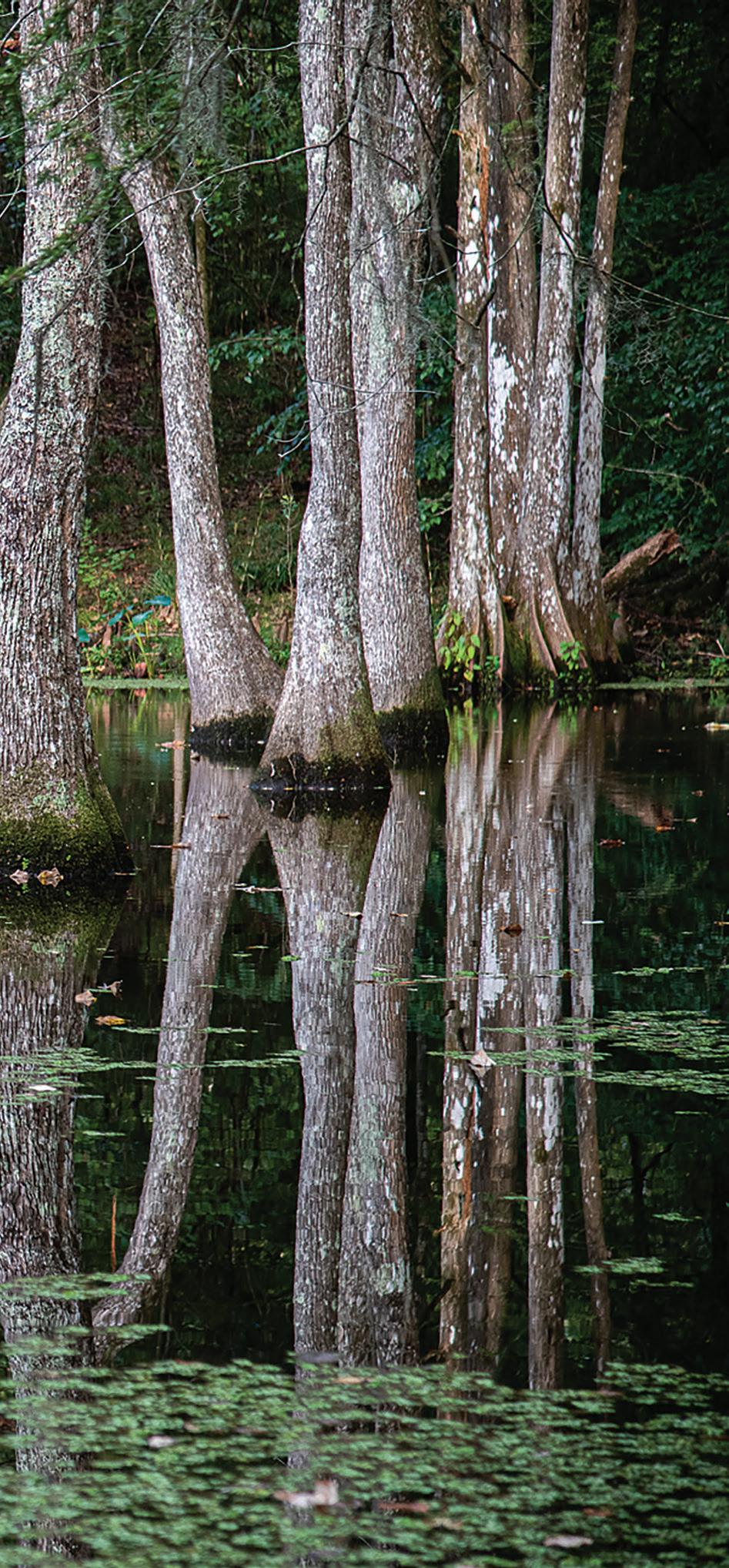
Hickories, oaks and plants provide food for wildlife in these forests that store water, filter pollutants and act as a floodplain.
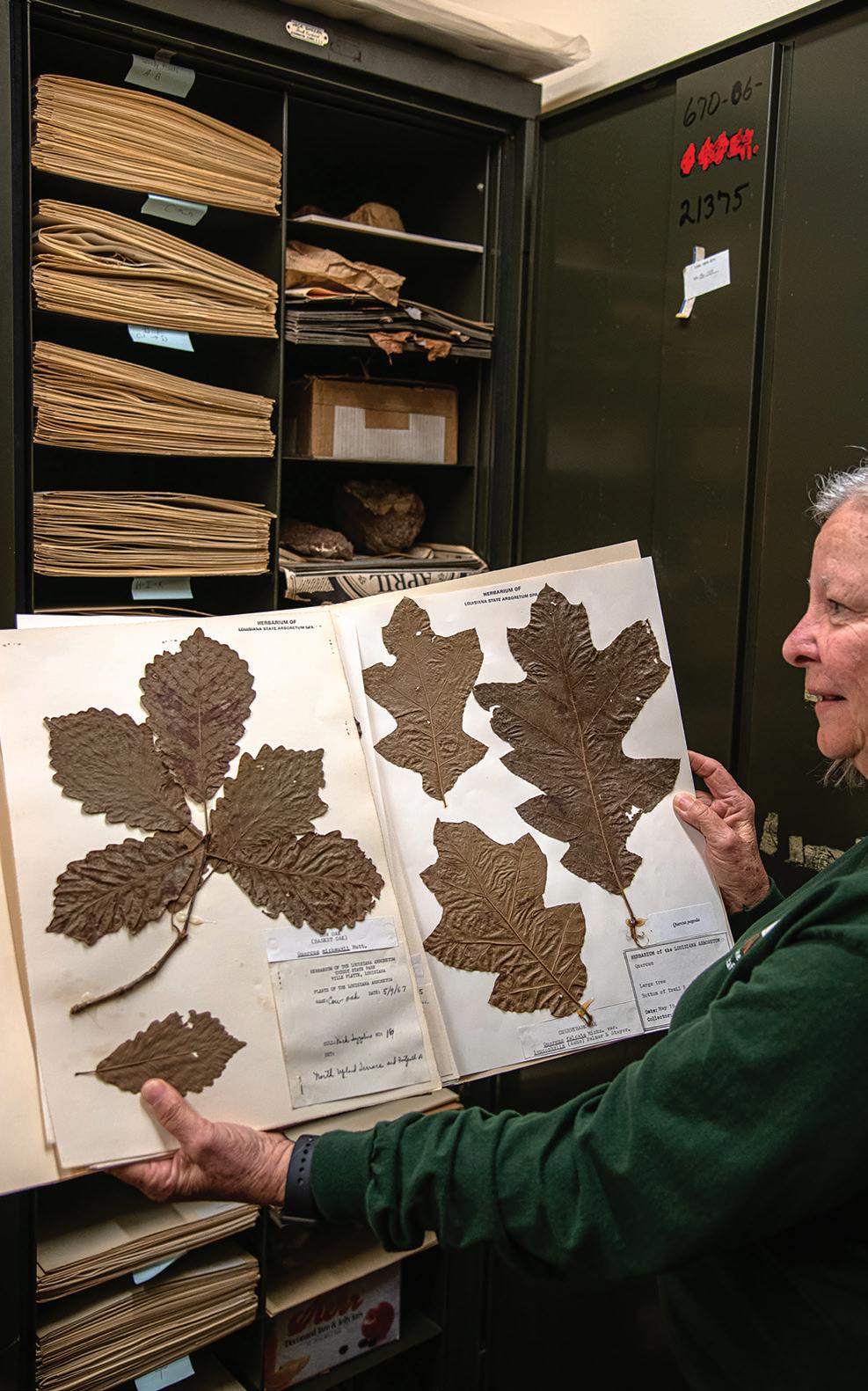
The Nature Center includes interactive learning activities and exhibits on local flora, fauna and woodlands.

“Our biggest problem is the weather,” says Hollier. In August 2020, winds from Hurricane Laura stood a 20-foot section of a boardwalk on the Walker Branch Trail upright. “I didn’t get very far,” Hollier says, remembering her first trek after the storm. She and the other two full-time staff members, including horticulturalist Emma Debenport, commenced clearing an area larger than Disneyland and nearly twice the size of Audubon Park in New Orleans. They worked in sections. One took an entire week to clear.
By that time, the Arboretum had already experienced a drastic loss of visitors due to COVID lockdowns. Then, in October 2020, Hurricane Delta struck the area. “We lost a lot of old trees during Delta,” Debenport says. “When you first see it after a storm, you think everything’s ruined. But it’s mending.” She notes that a few positives came out of the destruction: “I see new trees coming along, and new plants have now gotten enough sun to grow.”
Besides major storms, the Arboretum staff noticed that rains regularly flood the area behind the Nature Center.
To combat this problem, Debenport designed and built a rain garden. “It captures water, slows it down and allows it to percolate through soil instead of running off into the street or running off, in this case, into the lake,” she says.
Outside the Nature Center after a Friends of the Louisiana State Arboretum meeting, Rick Webb admires Debenport’s work. “It’s not just the plants,” he says, pointing out the native species, among them hibiscus, rain lilies, goldenrods, irises, aquatic milkweed and swamp milkweed. “She’s started an entire ecosystem.”
The Arboretum opened its Nature Center in 2009 under Jim Robinson’s direction. It offers wheelchair access to this cypress-tupelo swamp.

The State Arboretum contains six hiking trails, two of which are wheelchair accessible. Totaling 5.5 miles, these trails take hikers along a cypress-tupelo swamp, bottomland hardwood forest and along ridges of a beech-magnolia forest. The cypresstupelo swamp is home to the Arboretum’s tallest and oldest trees. Named the Louisiana state tree in 1963, bald cypresses can grow to 150 feet. Tupelos can reach 90 feet. Both species can live for 1,000 years.
The arboretum lies at a geographical crossroads where such an ecosystem can thrive. Jim Robinson, current president of the Friends of the Louisiana State Arboretum, first learned about the Louisiana State Arboretum through photographs. In that moment, he decided that he would one day work here. In the 1980s, he managed Chicot State Park and the Arboretum. Then for six years, he worked as an educator for the Louisiana Department of Wildlife and Fisheries, returning to the Arboretum in 1997 as manager and sole employee. He used his position to build the staff.
“With recreation sites, it’s like managing a city. You could have a business degree to manage a city, but not to run an arboretum. You have to know the history, flora and fauna, and you also have to be able to talk about these things,” he says, acknowledging his admiration for the skills of the Arboretum’s current staff. Pausing, he gazes at the gardens in front of the Nature Center. “I’ve loved this place from the first time I saw it,” he says.n
The Arboretum’s Nature Center contains a replica of a bald cypress with a plaque with details about Louisiana’s “Champion Trees.” The state’s largest bald cypress, on Cat Island in West Feliciana Parish, stands at 96 feet and 53 feet 11 inches in circumference. The largest live oak, the Seven Sisters Oak in St. Tammany Parish, is 55 feet tall, with a circumference of 36 feet 7 inches and limb spread of 132 feet. The largest loblolly pine — 157 feet tall, with a circumference of 12 feet 9 inches — grows in LaSalle Parish.


 BY CHERÉ COEN
BY CHERÉ COEN
We must admit we’re skeptical when people rave about Louisiana red and white varietal wines. Most vineyards in the Deep South produce sweet muscadine or fruitbased wines. But we were pleasantly surprised to find the hills of northern Louisiana not only producing varietals but offering fun destinations as well.
Jeff and Libby Landry began the trend when they moved their business north from Folsom after Hurricane Katrina destroyed their St. Tammany Parish vineyards. They discovered the North Louisiana hill country to be optimal for growing grapes and set up shop off Interstate 20 on rural Well Road in West Monroe.
The grapes grown in Landry’s Vineyards include blanc du Bois, lenoir/black Spanish and crimson cabernet. They also purchase grapes from California to serve 24 different wines in their tasting room, which is open Monday through Saturday. Visitors may tour the winery, vineyard and bottling facility on Saturdays.
New to the property is Landry Vineyard’s “Grape Escape” cottages, available for rent on Airbnb, which is great news since the vineyard routinely hosts concerts throughout the year. For instance, Code Blue and The Flatliners perform their rock, country and dance mix on Mother’s Day Weekend and there will be food trucks on hand, wagon tours through the property and wine for purchase. It’s the perfect opportunity to enjoy an outdoors event with spirits without having to drive. Lagniappe Saturdays are similar events, but featuring a single musician or duo on the front patio.
New to the north Louisiana wine scene is Thirsty Farmer Winery and Vineyard in nearby Calhoun, a winery and varietal vineyard begun in 2022 by Michael and Savannah Ray. Drive up the hill to the hip new tasting room to sample everything from a varietal flight to hard ciders and fruit-forward wines. Visitors may enjoy tasting their bounty to live music on Saturdays while viewing the surrounding vineyards.
Herons are perching all over Ouachita Parish — public art versions of the wetlands bird, that is. The Herons on the Bayou project matches bird sculpture templates with artists and the result has been a variety of colorful birds created and assembled throughout the twin cities of Monroe and West Monroe. On June 3, 13 new herons will be unveiled to bring the total of public art pieces to 100. Visit facebook.com/heronsonthebayou to find out where these herons will roost.

Monroe and West Monroe offer a fun escape and plenty to sip, see and eat
The Delta Biscuit Co. opened in Monroe to serve cocktails, brunch dishes and, of course, their own style of biscuit and the word has gotten out. Be prepared to wait at this new eatery started by husband and wife team Glen and Jessica Lewellyan, but it’s worth it.
Another newcomer is Flying Heart Brewing & Pub, which opened its second location along the Ouachita River in West Monroe (the first being in Bossier City). Visitors may enjoy their unique pizzas, giant pretzels and craft beers inside the oversized restaurant or outside on the back patio, a perfect setting for families.

After all that good eating, a hike through the woods may be in order. Kiroli Park in West Monroe offers 150 acres of trails, plus a dog park, expansive playgrounds, a peaceful lake and gardens.
Coming up this summer is the Red, White & Blue Airshow May 5-7 at the Monroe Airport with performances by the A10 Demo Team, Aeroshell Team, Kevin Coleman and more along with food trucks and vendors.
Ouachita RiverFest on May 13 in downtown West Monroe features live music, vendors, a rubber duck drop in the river, fishing tournament and a kids' area.
In June, art galleries throughout downtown Monroe and West Monroe will open their doors for the Downtown Gallery Art Crawl, an event held bi-monthly on the first Thursday of the month.
For more information, visit Monroe-West Monroe tourism at monroe-westmonroe.org.n

 BY CHERÉ COEN
BY CHERÉ COEN
Hold on, St. Augustine. You may be the oldest town in Florida, but Pensacola has a few bragging rights too. Spanish conquistador Don Tristán de Luna y Arellano landed in the Panhandle in 1559, six years before St. Augustine was founded.
So, OK, a hurricane interrupted Pensacola’s founding but the Spanish returned and founded Fort San Carlos de Austria in 1698, named for King Carlos II, Hapsburg King of Spain at the time. The French destroyed the fort when they took over the settlement in 1719 and its ruins exist today at the Naval Air Station Pensacola, not far from the Pensacola Lighthouse and Maritime Museum. Visitors to the Lighthouse can learn about the region’s unique history that goes beyond its founding, for Pensacola has served under five flags: Spain, France, Britain, the Confederacy and the United States.
The Fiesta Pensacola hosts more than 20 events throughout the year, including June’s 10-day celebration of the city’s founding and history. There’s the Grand Fiesta Parade, a boat parade, children’s activities and
the Fiesta All Krewe Ball, to name a few of the events. In the fall, the organization presents the annual Seafood Festival with music, arts and crafts and, of course, Gulf seafood.
Heart-stomping, awe-inspiring and the highlight of every air show, the Blue Angels Navy flight demonstration squadron makes its home in Pensacola at the Naval Air Station. You don’t have to wait until an air show comes to town to see them in action. The Blue Angels practice their aerobatics at NAS Pensacola on select days throughout the year. On certain Wednesdays, pilots visit the NAS Museum to sign autographs. Admission is free to watch, but check the NAS website for ID card requirements.
If you’re still itching for an air show, view the Blue Angels and others at the July 7-8 Pensacola Beach Air Show or Nov. 3-4 at the NAS Pensacola Homecoming Air Show. This year, the squadron’s 77th, the Blue Angels will perform 62 demonstrations at 32 locations.

Pensacola’s not just a beach town — although the Gulf beaches at Pensacola Beach, Perdido Key and the Gulf Islands National Seashore are some of the country’s finest. The city offers a wide variety of artistic entertainment, all located in the downtown historic district. Choose from the Pensacola Opera, Pensacola Symphony Orchestra, Ballet Pensacola, the historic Saenger Theatre and the Pensacola Museum of Art. Downtown also features numerous galleries, many that showcase Panhandle artists, and the First City Art Center. Theatre-lovers may want to take in a performance at the Pensacola Little Theatre.
For information on things to do in Pensacola, visit visitpensacola.com. n
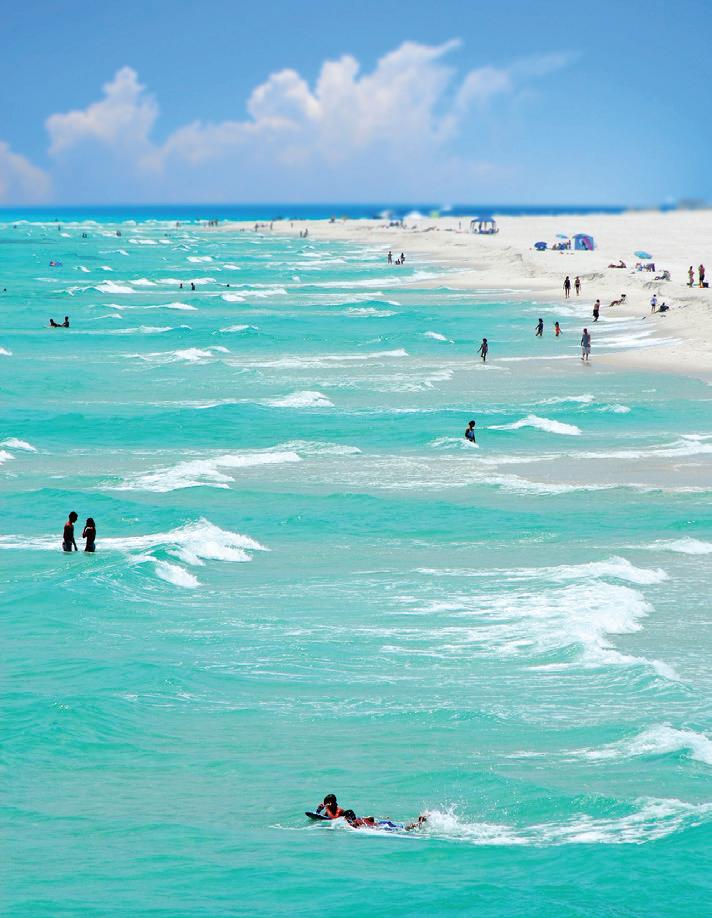
Places to bring the family that won’t break the bank — heck, they’re free — abound in Pensacola and surrounding areas. First and foremost are the beaches, naturally, but don’t miss the Sand Eco Trail on Pensacola Beach where signage tells the story of the region’s rich ecology. You might even spot a nesting seabird or turtle. There’s the weekly Palafox Market on Saturdays and nearby St. Michael’s Cemetery, dating to the 1700s, is one of the oldest in Florida. The National Naval Aviation Museum, where the Blue Angels practice, has no admission fees and free parking. However, special attractions, such as films and flight simulators, do require tickets.

 BY GAVIN CLINTON, PINEVILLE
BY GAVIN CLINTON, PINEVILLE

